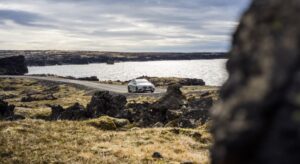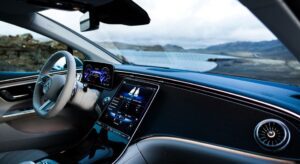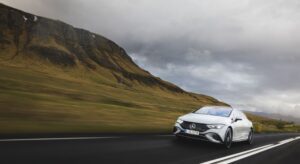This website uses cookies so that we can provide you with the best user experience possible. Cookie information is stored in your browser and performs functions such as recognising you when you return to our website and helping our team to understand which sections of the website you find most interesting and useful.
Land of fire, ice…and electricity: test-driving Mercedes-Benz all-electric saloon
By Rory FH Smith | 22 June 2023 | Cars & Yachts, Travel
We take a road-trip to see whether the marque’s new EV gets the green light

Mercedes-Benz EQE Saloon
“Welcome to Iceland; the land of fire, ice and electricity,” my driver tells me as we pull away from Reykjavik airport. With a rich mixture of geology and its northerly location, the nation has extensive access to renewables, meaning almost 100% of the electricity consumed in this small country of 330,000 people comes from renewable sources. Put simply, Iceland is as green as it gets when it comes to energy generation and consumption – so much so that the United Nations holds it up as a global leader in sustainability.
Good news in an age when energy prices are spiralling and the world’s appetite for electrons is increasing exponentially. Against this backdrop, Iceland makes a lot of sense, which is no doubt why Mercedes-Benz has sought it out as the place to launch its latest all-electric saloon, the EQE. Following in the footsteps of its sibling the EQS, Mercedes’ latest take on its best-seller family saloon sports the same rounded aerodynamic design – something Bastian Baudy, the Mercedes’ team lead for exterior design, labels as ‘one-bow’ design.
This slick new design language sets Mercedes’ EQ electrified models apart from its range of combustion-engine cars, with the slippery new profile aiding aerodynamics – a key ingredient in the battle for more efficient and longer-range electric vehicles. While the existing family favourite E-Class saloon is still on sale alongside its electric cousin, the EQE commands a significant premium, with prices starting from £73,450 compared to £45,575 for the conventionally powered model.
On first approach outside the Reykjavik Edition hotel in the Icelandic capital’s harbour, it’s difficult to tell the EQE apart from its more luxurious sibling – only the slightly shorter length gives away that this model sits just below the EQS in the luxury saloon game. Against the dramatic backdrop of a moody sea, giant fishing trawlers and rolling hills behind, its flowing lines, squat stance and smooth front end make quite the impression. Packing a 90kWh battery, the 500 spec EQE has a range of just under 400 miles and a power output of 408bhp – enough to power the entirety of my all-electric, renewable energy-powered road trip to Vik at the tip of Iceland’s southern coastline. Heading off on the scenic route, which measures in at over 300miles, the drive should be well within the range of the EQE’s real-life range.

EQE Interior
Once out on Iceland’s deserted country roads, it’s easy to see why the EQE commands such a premium on its combustion-engine cousin, the E-Class. The EQE’s tech-heavy, spaceship-like cockpit goes well with Iceland’s lunar landscape on the country roads to the east of the capital. Dominating the dashboard is a central touchscreen, twinned with another 13in driver info screen that replaces the normal dash dials and display. Controlling everything from the seat massagers and internal ambience to the media, navigation and car set-up, the EQE’s digital-first dash is a significant step up from the norm. For those seeking a screen detox when they step into their car, the EQE’s arrangement will be alarming; especially in the AMG EQE 53 version, which has the option to select Mercedes’ enormous 56in Hyperscreen, which turns the entire dashboard into an all-dominating digital display.
THE SOUND OF SILENCE
Gliding through Iceland’s desolate lava fields, the car pulls well, with power and performance that almost outmatches the car’s stately saloon car set-up. Acceleration is the party piece of most electric cars and the EQE is no exception – the 500 model pulls off the 0-60mph dash in just five seconds, while the lower-powered 350 does it in 7.3 seconds and the range-topping AMG 53 in a rapid 3.5 seconds.
Making my way around the vast rift valley lake of Thingvallavatn, to the east of the capital, the EQE comes alive on the narrow, twisting roads. With views down to the crystal clear, ice-cold water below, I weave my way around the jagged rocky outcrops and deserted roads as the sun beats down through the EQE’s panoramic glass roof. The silent driving that comes with electric cars is refreshing in any setting but even more so when driving through Iceland’s spectacularly scenic countryside.

EQE Saloon
Once I’ve navigated the long way around Thingvallavatn lake, I continue southeast to sample some of Iceland’s most sought-after landmarks – its wild and wonderful waterfalls. Like something from the pages of a fantasy film, falls like Skógafoss and nearby Seljalandsfoss conjure up images of post-Ice Age landscapes, which were defined by ferocious torrents of glacial meltwater. Plummeting off sheer cliff edges, Iceland’s Skógá and Seljalandsa river flow down into deep crevasses that cut through the green and grey-mottled, treeless landscape. Despite its healthy supply of renewables, trees are not readily found in Iceland ever since Viking settlers took their axes to the forests that covered one-quarter of the countryside.
Approaching Vik, my final destination on the south coast before heading back to the capital, I’d usually be looking forward to taking a break after a full day of driving. But the rich mixture of the EQE’s silent and comfortable drive, combined with the jaw-dropping scenery spurs me on. Arriving at Vik, its jet-black beaches, towering offshore stacks, sheer cliffs and swirling plumes of puffins are more akin to Middle Earth than anywhere on our planet. It’s a fitting and awe-inspiring end to my Icelandic adventure.
In the same distance between London to Exeter, I’ve seen lava deserts, crystal-clear glacial lakes, waterfalls that plummet from great heights and black beaches that stretch for miles. Iceland is an enchanting place and its wonders serve as a poignant reminder of the world we must maintain. We can hope that the remarkable way in which the country makes use of renewables will travel further overseas in time, if only to power the burgeoning number of electric cars around the world.

Mercedes-Benz EQE Saloon in Iceland
In the meantime, Mercedes’ choice of location to launch its latest car doesn’t just to serve as a beautiful backdrop, but also as a powerful reason to go green.







